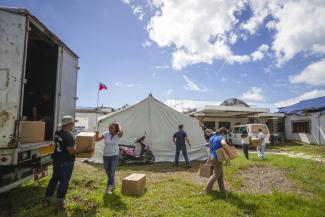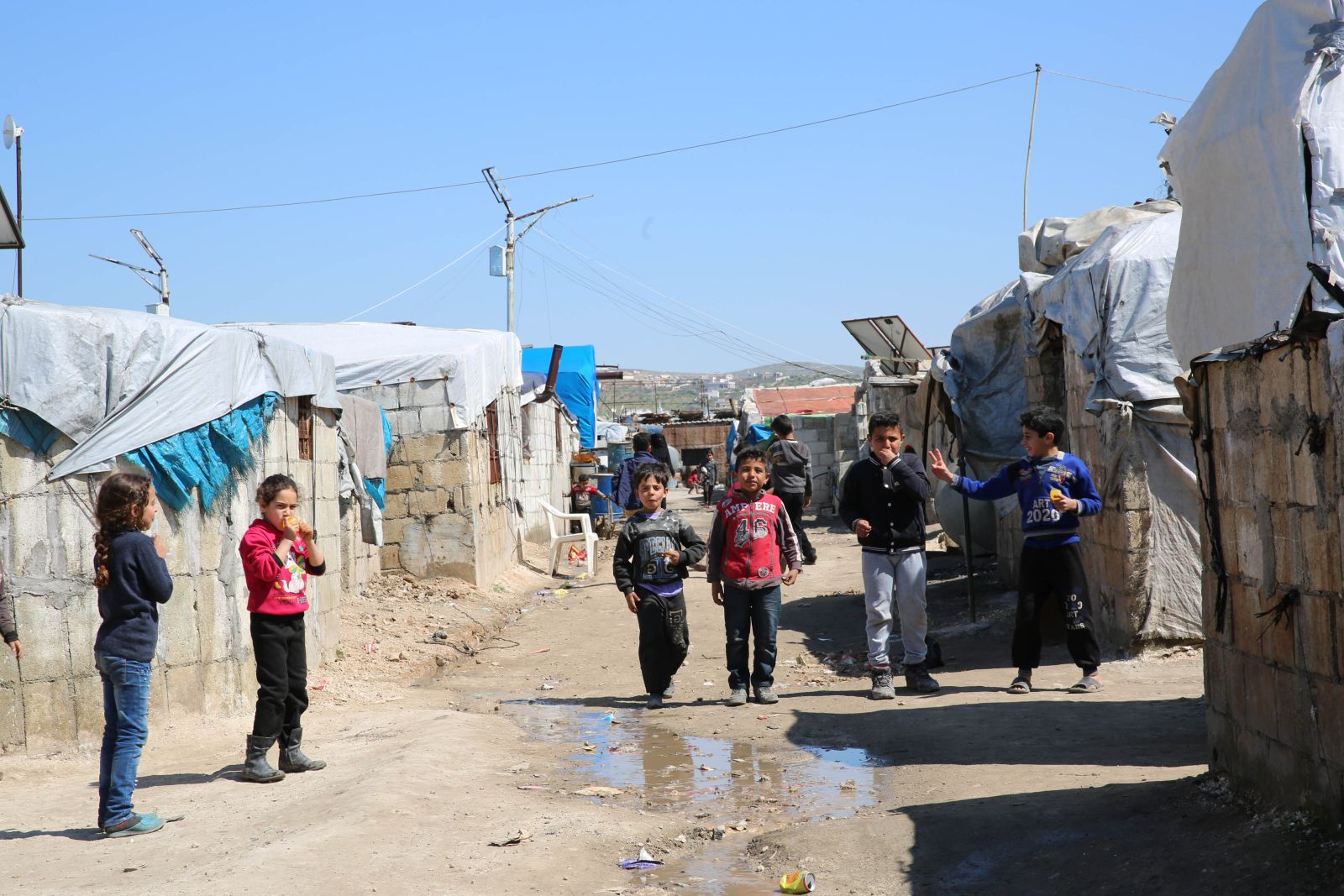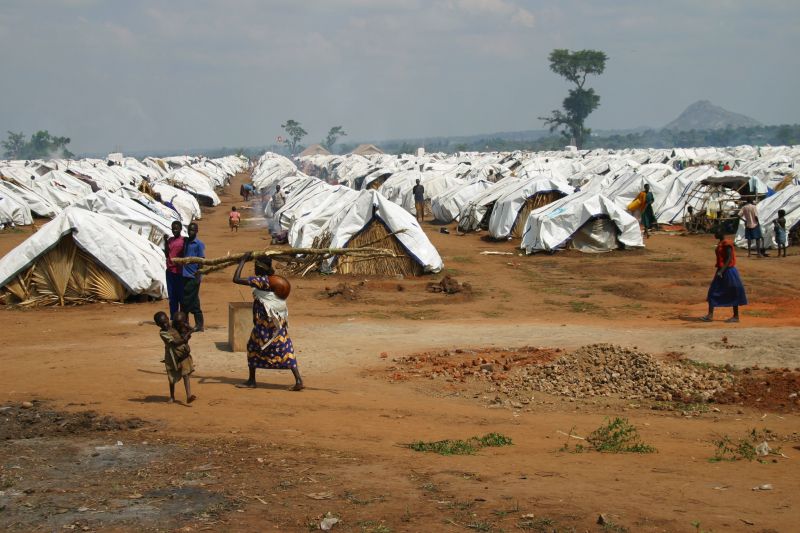Pharmaceuticals
Needs-based care in disaster situations

In a disaster, four dreaded infectious diseases can break out and become life-threatening problems, especially for children. They are respiratory infections, diarrhoea, measles and malaria. In many conflict areas, they cause 60 % to 90 % of fatalities.
The SPHERE project is a voluntary alliance of organisations committed to improving humanitarian aid and helping practitioners to become reliable partners for donors and affected communities. The SPHERE handbook “Humanitarian Charter and Minimum Standards in Humanitarian Response” is a useful tool for disaster relief workers. Now in its 11th edition and published in many languages, it is a widely known and internationally recognised set of general principles and universal minimum standards for disaster relief operations.
Measures to prevent infectious disease and facilitate treatment are a core concern for SPHERE. They are described in the chapter Minimum Standards in Health Action. Relevant issues include the choice of appropriate accommodation at appropriate locations, sufficient water supply, good water quality, appropriate sewage disposal, adequate sanitation, prophylactic vaccination, vector control and health education.
Quality standards in humanitarian aid
As soon as a disease outbreak occurs, everyone affected must get access to diagnosis and treatment. Certain programmes run by the World Health Organization (WHO) – such as Integrated Management of Childhood Illnesses (IMCI) and Integrated Management of Adult Illnesses (IMAI) – have developed important procedures to help ensure correct diagnosis at an early stage, thereby reducing mortalities from communicable diseases.
The outbreak of an infectious disease needs to be identified and addressed swiftly to prevent an epidemic. SPHERE offers guidance on an early warning system (EWARN) for outbreak detection; in the case of some highly infectious diseases such as cholera, measles and meningitis, provision is made for weekly surveillance with the immediate reporting of new cases. Once an outbreak has been confirmed, measures must be taken:
- to contain the infection (by isolating patients, for example),
- to break the chain of infection (by implementing vaccination campaigns, for example, or providing safe drinking water) and
- to deliver diagnosis and treatment fast and comprehensively.
In addition to preventing the spread of communicable diseases by vaccination campaigns and hygiene measures such as provision of clean water, washing hands and building toilets, medical workers need sufficient access to appropriate, high-quality medicines for treating patients.
WHO kits for rapid relief
In emergency and catastrophe situations, medical teams use a standardised kit that was developed by the WHO and major international NGOs. Known as the Interagency Emergency Health Kit, it contains medicines, supplies and other items required to meet the needs of affected communities. The kit is designed to cater for 10,000 displaced persons for a period of three months. It comes at a reasonable price and can be purchased from commercial and non-profit pharma wholesalers. Delivery is possible within hours.
The kit consists of ten basic units and a so-called supplementary unit. Each basic unit caters for a thousand children and adults and is designed for use by health workers without formal training. The supplementary kit contains medicines and medical devices (equipment and renewables) that allow surgical procedures to be performed. It is intended for use by physicians and senior health-care workers with professional skills.
The basic kit contains disinfectants and the antibiotic amoxicillin tablets for the prevention and treatment of communicable diseases. Where complex infections are present or resistance is suspected, patients should be referred to hospitals at the next higher level. Because eye infections tend to be common where hygiene conditions are poor, the basic kit also contains an antibiotic eye ointment (1 % tetracycline). A supplementary module can be ordered for treating malaria.
The supplementary kit contains water-treatment tablets and various antibiotics for the oral and intravenous treatment of infections. Where a cholera outbreak is feared – or an epidemic of diarrhoeal disease caused by other organisms – the WHO Interagency Diarrhoeal Disease Kit is useful. Apart from large quantities of disinfectants, it also contains everything needed for fluid replacement: oral rehydration solution, infusions, cannulas, scalp vein sets, et cetera. Recommended antibiotics include doxycycline, erythromycin and ciprofloxacin.
During initial relief efforts, the SPHERE standard recommends checking which medicines are on the national list of essential medicines. In cooperation with national health authorities, it should be assessed whether that list is appropriate for the case at hand. If so, international aid should ensure all listed medications are available – if necessary, by donating drugs.
Needs-based aid
Pre-packed standardised kits are part of a “push system”. For the sake of speed, they do not consider individual recipients’ needs. Asymmetrical consumption patterns quickly result in over- or understocking.
Some aid organisations that specialise in pharmaceutical support such as action medeor, Apotheker helfen and Apotheker ohne Grenzen, can provide professional support that takes account of patients’ needs. After Typhoon Haiyan struck the Philippines in 2013, for instance, or after the earthquake in Nepal in 2015, action medeor set up temporary medical distribution centres in the countries concerned. National specifics and requirements were considered in constant consultation with government agencies as well as medical workers active on the ground. The distribution centres helped to ensure that health stations, hospitals as well as national and international medical teams had stocks of appropriate high-quality medicines and medical supplies. This kind of system is called a “pull system” because the users have an impact on what is delivered. In the course of disaster management, there is generally a switch from push to pull systems.
To permit effective, targeted treatment of infectious diseases, medical workers need access to a sufficiently large selection of medicines. Above all, they may need antibiotics to fight pathogen strains that are resistant or less susceptible to certain pharmaceuticals.
Medical aid organisations need a medicine management system that is not just effective and cost-efficient, but also addresses issues such as correct storage, rational use and disposal. This applies to small medical teams as well as to the organisation and administration of drug donations at regional or national levels.
Aid organisations specialised in pharmaceutical support can offer support and backup in this context – for example, by organising preparatory training programmes for medical teams in Germany or providing support, supplies and medicine management services for teams active on the ground.
Shushan Tedla is an Eritrean pharmacist with a master’s degree in international health from a German university. She works for action medeor and has acted as pharmaceutical manager for temporary medical distribution centres in the Philippines and Nepal.
shushan.tedla@medeor.de
https://medeor.de/en/
Irmgard Buchkremer-Ratzmann is a pharmacist with experience in research and industry. She heads the pharmacy department at action medeor and coordinates pharmaceutical advisory services.
irmgard.buchkremer@medeor.de
Links
SPHERE Handbook, 2011:
http://www.sphereproject.org/
WHO Interagency Emergency Health Kit:
http://www.who.int/medicines/publications/emergencyhealthkit2011/en/











